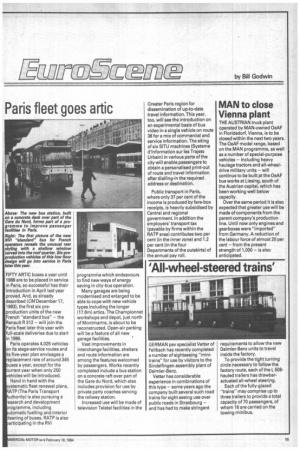Paris fleet goes artic
Page 57

If you've noticed an error in this article please click here to report it so we can fix it.
FIFTY ARTIC buses a year until 1988 are to be placed in service in Paris, so successful has their introduction in April last year proved. And, as already described (CM December 17, 1983), the first six preproduction units of the new French "standard bus" — the Renault R 312 — will join the Paris fleet later this year with full-scale deliveries due to start in 1986.
Paris operates 4,025 vehicles on its stage-service routes and its five-year plan envisages a eplacement rate of around 345 uses a year, except for the urrent year when only 250 ehicles will be introduced. Hand in hand with the ystematic fleet renewal plans, ATP (The Paris Transport uthority) is also pursuing a esearch and development rogramme, including utomatic fuelling and interior leaning of buses. RATP is also articipating in the RVI programme which endeavours to find new ways of energy saving in city-bus operation.
Many garages are being modernised and enlarged to be able to cope with new vehicle types including the longer (17.6m) artics. The Championnet workshops and depot, just north of Montmartre, is about to be reconstructed. Open-air parking will be a feature of all new garage facilities.
Vast improvements in interchange facilities, shelters and route information are among the features welcomed by passengers. Works recently completed include a bus station on a concrete raft over part of the Gare du Nord, which also includes provision for use by private party coaches serving the railway station.
Increased use will be made of television Teletel facilities in the Greater Paris region for dissemination of up-to-date travel information. This year, too, will see the introduction on an experimental basis of bus video in a single vehicle on route 38 for a mix of commercial and service information. The siting of six SITU machines (Systeme d'Information sur les Trajets Urbain) in various parts of the city will enable passengers to obtain a personalised print-out of route and travel information after dialling-in the required address or destination.
Public transport in Paris, where only 37 per cent of the income is produced by fare-box receipts, is heavily subsidised by Central and regional government. In addition the employers' transport tax (payable by firms within the RATP area) contributes two per cent (in the inner zone) and 1.2 per cent (in the four Departments of the outskirts) of the annual pay roll.




















































































